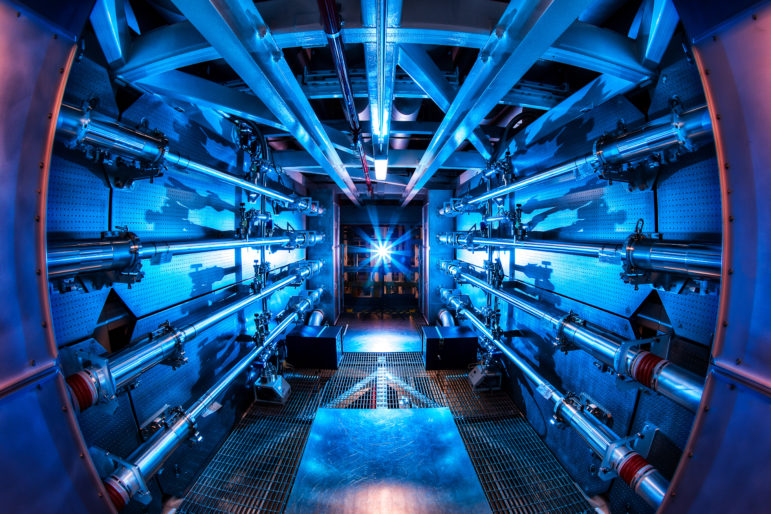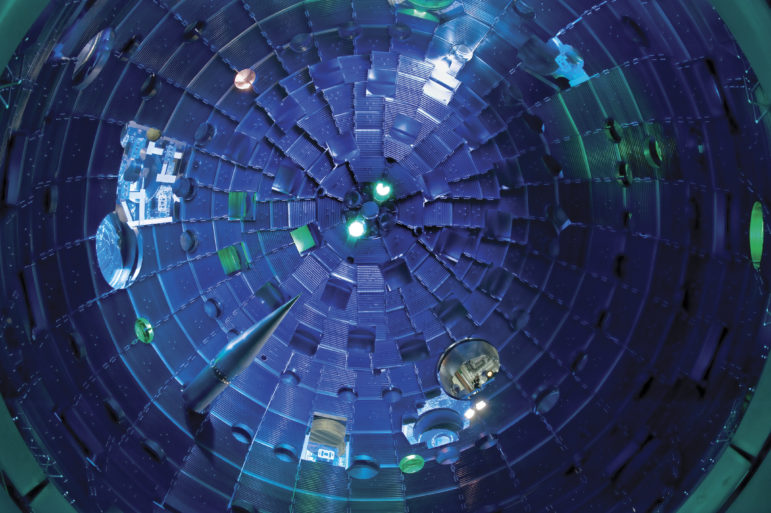
Today’s article comes to us from Amethysta Herrick. She lives in Colorado, studies with the Order of Bards, Ovates, Druids, and recently shifted from developing software to developing ideas. Her writing focuses on the origin of identity as a nexus among biology, psychology, society, and spirituality. Follow her work at https://amethysta.io.
On December 05, 2022, the National Ignition Facility (NIF) at Lawrence Livermore National Laboratory (LLNL) achieved a spectacular technical feat. For the first time in human history, a controlled nuclear fusion reaction reached scientific energy breakeven – more energy was generated by the reaction than was required to initiate the reaction. NIF worked toward this goal for approximately a decade, and the result is a critical milestone not just for nuclear fusion research, but energy production in general.

National Ignition Facility, a ten-story building the size of three football fields located at Lawrence Livermore National Laboratory. Image credit: Lawrence Livermore National Security – CC BY-SA 3.0
What did the experiment mean? Why was it so important? Is this the dawning of a new era in global energy consumption? The press release from LLNL contains gushing statements from many politicians hoping to ride to re-election on its coattails. Unfortunately, the ramifications of the experiment’s result do not match its technical achievement. Instead, the sprawling waste of money and energy demonstrates a deep denial of the gravity of anthropogenic climate change and our rapidly shrinking chances to address the mess we have created.
Nuclear Reactions
Nuclear reactions are not new to scientists. The Manhattan Project demonstrated the viability of nuclear reactions during World War II, resulting in extremely powerful weapons. However, those weapons – and today’s nuclear power generation plants – differ from the reaction Lawrence Livermore National Laboratory achieved.
Today’s nuclear power generation plants utilize a type of reaction called nuclear fission. When an atom undergoes fission, its nucleus splits into multiple products in a process called radioactive decay. For example, naturally occurring uranium decays either to thorium or protactinium and a helium atom. In the process, significant heat is also generated, which is used in a nuclear power generation plant to heat water to steam to turn an electrical turbine into a highly advanced steam engine.
In contrast, the reaction LLNL studied is nuclear fusion. Instead of the nucleus splitting apart, a fusion reaction occurs when multiple nuclei come together to form a single nucleus. The best example of a fusion reaction is what powers our Sun – hydrogen nuclei fuse together to generate helium nuclei (and, again, a significant amount of heat).
Whereas only certain nuclei are capable of undergoing fission, all nuclei will undergo fusion under the right conditions. Every nucleus on Earth and across the Universe was formed initially from hydrogen nuclei in the center of a star – including the uranium that will later decay radioactively.
As a result, fusion reactions are believed to be “cleaner” than fission reactions. In a fission reaction, sometimes the products are worse than the reactants. Nuclear waste from fission power generation plants pose an environmental risk that spans millenia – waste facilities are designed to last 10,000 – 100,000 years. Fusion products, on the other hand, could be as benign as helium, used for balloons at your daughter’s birthday party after exiting the fusion reactor.
Fission reactions are common – wristwatches that glow with tritium are easily available and affordable. Fusion reactions are uncommon – the conditions necessary to initiate one are far more difficult to achieve than naturally-occurring fission. How difficult? LLNL built an entire facility to attempt these reactions.
The National Ignition Facility
The National Ignition Facility at Lawrence Livermore National Laboratory is “the world’s largest and most energetic laser system.” To be clear, NIF is a stunning technical achievement. The building is 85 feet tall, covers an area larger than three football fields, and cost roughly $3.5 billion dollars to construct and be ready for operation.

Preamplifier at the National Ignition Facility – Image credit: Damien Jemison/Lawrence Livermore National Laboratory – CC BY-SA 3.0
NIF contains laser bays that amplify an initial weak laser pulse more than a millionfold. The laser diverges into 192 separate beams that pass around the spherical reaction chamber to converge again inside it. All 192 optical paths must be tuned individually to allow the laser pulses to arrive at precisely the same time at a target the size of a peppercorn.
The reaction chamber itself is housed in a concrete silo 30 meters high and 30 meters in diameter. It is constructed from 10-centimeter-thick aluminum panels. On the inside, the chamber is evacuated to minimize laser scattering, then cooled with liquid helium to an average temperature of 18 Kelvin (ca. -427 Fahrenheit).
The lasers converge on a deuterium and tritium fuel pellet coated with a material that implodes in the intense heat. In this way, the fuel pellet is similar to the methodology used to detonate modern nuclear weapons – rather than compressing the fuel to cause a fission chain reaction, however, the fuel is heated and compressed with the hope of igniting a fusion reaction.
During the experiment, the fuel pellet undergoes temperatures and pressures many times greater than the center of our Sun. It is no exaggeration to say that NIF is the most complicated nuclear reaction chamber extant, nor is it any surprise that it took another decade after the facility was commissioned to achieve the results on December 05, 2022. That is how much more difficult fusion reaction conditions are to achieve than fission reaction conditions.
Scientific Energy Breakeven
Not only has NIF demonstrated its ability to ignite a fusion reaction, the results achieved on December 05, 2022, demonstrated scientific energy breakeven. The amount of energy released by the fusion reaction was almost 50% greater than the amount of energy put into the reaction chamber to initiate it.
How much energy was put into the reaction? According to the press release, approximately 2.1 million joules were delivered in 20 nanoseconds. NIF measured approximately 3.15 million joules released by the reaction. With this result, NIF demonstrated the possibility of inertial fusion energy (IFE). But did NIF demonstrate viability for IFE?
An average home in the United States uses 11,000 kWh of power annually. Averaged out over the course of a year, that implies approximately 0.35 joules / second. By a very rough calculation, the amount of power taken to initiate the fusion reaction was likely enough to power the city of Chicago for about 10 seconds. The entire city of Chicago, for ten seconds…. to initiate one reaction.

View from the bottom of the National Ignition Facility target chamber shows the target positioner being inserted. Pulses from NIF’s high-powered lasers race toward the Target Bay at the speed of light. They arrive at the center of the target chamber within a few trillionths of a second of each other, aligned to the accuracy of the diameter of a human hair. Image credit: Lawrence Livermore National Security – CC BY-SA 3.0
That said, NIF demonstrated scientific energy breakeven – in other words, what is reported is only the energy delivered to the reaction chamber. In reality, NIF requires pumps, cryogens, laser amplifiers, air conditioning, server rooms, etc., with all the associated inefficiencies compounded. The facility itself also took almost a decade to build and another decade to get to this fusion reaction result.
What NIF demonstrated is a technical achievement. But it is no achievement in the field of energy production.
NIF and the Future
The reaction chamber at NIF is not ready for mass production. We will not have fusion reaction chambers in towns across the United States soon. In fact, I predict never. Why do I pass such harsh judgment on fusion reactors? It is the inconvenient truth of the net energy ratio.
Net Energy Ratio (NER) is the ratio of the amount of usable energy acquired from an energy source to the amount of energy expended to obtain the energy source. NIF has harvested approximately 1.1 million joules from 20 years of operation and experimentation. To be clear – reversing my rough calculations from before – 1.1 million joules should power the city of Chicago for about 5 seconds, which is impressive.
The trouble is that building fusion reactions will require current sources of power, which means petroleum. And despite what any politician or talking head has said to the contrary, oil is a finite resource that is running out. The only reason humanity has continued to “find” new sources of petroleum is that its cost has risen sufficiently to make progressively ridiculous methods of extracting it economically viable. This will not continue.
A prediction in a commentary on NIF’s results was that it would take another 70 years before fusion reactors were cheap enough to be commercially viable sources of energy. Sisters and brothers, we do not have that time. We must act now to conserve enough energy to convert back to how humanity existed 300 years ago.
NIF reported an exceptional experimental result. Now let us get our heads out of the Religion of Science long enough to face the practical reality that – regardless of our wishes – it will not save us.
The Wild Hunt is not responsible for links to external content.
To join a conversation on this post:
Visit our The Wild Hunt subreddit! Point your favorite browser to https://www.reddit.com/r/The_Wild_Hunt_News/, then click “JOIN”. Make sure to click the bell, too, to be notified of new articles posted to our subreddit.